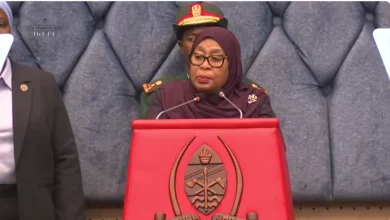On a day of winds, President Samia reawakens Tanzania’s sense of purpose

DODOMA: ON November 14, 2025, the atmosphere in Dodoma carried a strangely human warmth, the kind that settles in when a country pauses to listen to its leader after months of tension. There was no mistaking the weight of the moment.
Crowds outside Parliament lingered as if wanting to touch the edges of history, while inside, President Samia Suluhu Hassan stepped to the podium with the kind of calm that comes only from someone who understands both the fragility and the resilience of a nation.
Her presence alone seemed to steady the hall and for a moment the air felt lighter, as if the country itself had exhaled. As she began to speak, there was a tone that blended steadiness with an emotional honesty rarely seen in political addresses. She acknowledged, without defensiveness, the pain and uncertainty that had followed the disputed elections.
Yet her message was not one of retreat or blame. It was one of responsibility, of choosing to carry the weight rather than shift it. What struck many was her appeal to the young people of Tanzania, a message that resonated beyond the chamber walls.
She reminded them that peace does not survive by accident but through deliberate choices made every day by ordinary citizens. Her words did not come across as admonition; they had the softness of experience, the sort that comes from having watched a nation evolve through challenges and triumphs over decades.
Her reflection on the October unrest was sobering but grounded. She did not hide from the fact that many young people were swept up by the emotions of the moment. Instead, she offered context, speaking almost like a mother guiding her family back to the centre.
She urged them not to burn the country they will eventually lead, not to cut the very branch on which they stand. It was a reminder that development is not only measured in roads or buildings, but also in the maturity with which a society navigates its storms.
Her appeal echoed the sentiments of older generations who have seen the delicate threads that hold peace together and it bridged a gap that had been widening between the youth and the political sphere.
Yet her message was not directed only at the youth. She made it clear that the government itself must reflect, recalibrate and learn. A commission has already been formed to examine the events, and her insistence on accountability suggested a willingness to confront difficult truths.
It was a signal that leadership in her vision does not hide behind authority, but moves toward transparency, however uncomfortable that may be. This alone sets a new tone for political culture in Tanzania, where past governments were often guarded in moments of public tension. Her approach invites participation, implying that the path forward requires shared responsibility rather than directives issued from a distance.
Her call for forgiveness for those who simply followed the crowd during the protests was another notable gesture. It was not a sweeping dismissal of wrongdoing, but a recognition that young people sometimes act from confusion or misplaced loyalty rather than malice.
This approach, measured yet compassionate, underscored her belief that unity cannot be built on punishment alone. Her directive to reconsider charges against those caught in the chaos communicated something deeper: That reconciliation is a process that involves understanding as much as justice. It acknowledged the humanity of those involved while still upholding the importance of order, a balance that many leaders struggle to achieve.
Throughout her address, she spoke of Tanzania’s identity as a nation built on peace and unity. While some may dismiss such remarks as ceremonial, the cadence of her words carried lived familiarity. She drew on the history of generations who built the country not with excess resources but with perseverance.
The quiet confidence with which she spoke hinted at someone who understands the emotional architecture of the country, the threads holding communities together and the anxieties threatening to pull them apart. Her tone held that comforting sense of someone who has watched storms come and go and still believes in the sunlight that follows.
There was also a practical side to her speech, a look toward the future that did not ignore the present. She emphasised opportunities for young people, not only in employment but in shaping the nation’s direction. By linking civic responsibility to personal potential, she reframed national development as something intimate, not abstract.
any young listeners later said that they felt seen rather than scolded, a distinction that matters in a generation increasingly sensitive to political tone. It may be this ability to connect emotionally that continues to differentiate her leadership in a region where politics can at times feel distant from ordinary lives.
The political context made her address even more significant. After an election season marked by strong emotions, her calm articulation of unity served as a counterweight. Rather than attempting to sweep controversies under the rug, she acknowledged them while emphasising the collective responsibility to move forward.
This choice helped shift the discourse from rivalry to reflection. Diplomats, analysts and citizens alike noted that her words suggested a roadmap for healing, not through denial but through engagement. In this sense, the speech may be remembered as one of her most pivotal moments, not for bold promises but for the sincerity that shaped its delivery.
It is worth noting that her leadership style, often emphasising patience and dialogue, has gradually reshaped political expectations. Even critics admit that her ability to maintain composure under pressure has strengthened the country’s image abroad. By inviting discussion rather than confrontation, she opened space for a more inclusive political atmosphere.
Whether this will translate into tangible reforms remains to be seen, but the tone she set today may become a reference point in future political debates. Her approach suggests that stability is not imposed but nurtured through continuous, honest engagement.
What remains clear is that Friday’s address was not merely ceremonial. It was a national pulse check, an invitation to rebuild trust and a reminder that democracy is not preserved solely through elections but through continuous engagement between leaders and citizens.
As she concluded her speech, there was a lingering sense that she had managed to reach the audience not only through policy but through sincerity. The applause that followed was not overly dramatic but carried the sound of people who had been waiting for a moment of reassurance after weeks of uncertainty.
In the end, her words offered more than political comfort. They suggested a nation capable of recalibrating itself without tearing at its seams, a people willing to reconsider their assumptions and a leader prepared to walk with them rather than ahead of them.
If Tanzania continues along this path, that day may be remembered as one of those subtle turning points that quietly shift a country’s trajectory. And perhaps that is the most enduring aspect of her address: A belief that, despite tension, uncertainty and recent turbulence, Tanzania’s story is still one of possibility.
ALSO READ: Samia’s speech earns kudos
In conversations outside the chamber afterwards, people spoke not only about what she promised, but how she made them feel, reassured, challenged and strangely hopeful. It is often said that leadership is tested most deeply in uneasy moments, and today she demonstrated a willingness to meet the country exactly where it stands. That willingness may prove more valuable than any single policy, for it builds the trust on which all progress must rest.
As the sun set over Dodoma, many felt that something subtle had shifted, a small but meaningful restoration of confidence. The path ahead remains demanding, yet with renewed commitment and a leader embracing dialogue, Tanzania may find the steady ground expected.





